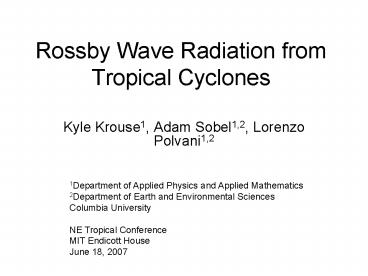Rossby Wave Radiation from Tropical Cyclones - PowerPoint PPT Presentation
1 / 19
Title:
Rossby Wave Radiation from Tropical Cyclones
Description:
1Department of Applied Physics and Applied Mathematics ... vorticity and wind from NCEP Reanalysis, from Sobel and Bretherton (2000) ... – PowerPoint PPT presentation
Number of Views:36
Avg rating:3.0/5.0
Title: Rossby Wave Radiation from Tropical Cyclones
1
Rossby Wave Radiation from Tropical Cyclones
- Kyle Krouse1, Adam Sobel1,2, Lorenzo Polvani1,2
1Department of Applied Physics and Applied
Mathematics 2Department of Earth and
Environmental Sciences Columbia University NE
Tropical Conference MIT Endicott House June 18,
2007
2
TCs, being vortices, radiate Rossby waves in the
presence of PV gradients
Snapshot of 850 hPa Abs. vorticity and wind from
NCEP Reanalysis, from Sobel and Bretherton (2000)
3
This energy dispersion can lead to genesis of a
second TC (e.g. Frank 1982 Davidson and Hendon
1989)
TC Jelawat inducing TC Ewinar in WNP, Aug., 2000.
From Li et al, 2003
4
What controls whether or to what extent wave
radiation occurs? What sets the wavelength?
5
We look at this process with simple numerical
experiments
- Shallow water equations on sphere
- Mass equation forced by relaxation to specified
function of position, - he is a constant plus a Gaussian depression
time scale also Gaussian, minimum at mass sink
center (so no far-field damping of waves) - This produces a vortex we move it by forcibly
moving the mass sink at a constant velocity - Velocity and amplitude of mass sink are varied
6
Westward vortex motion is necessary in order to
obtain a zonal wave train as in observations
Note U here is defined as the opposite of the
vortex translation velocity Ugt0 westward
vortex motion
7
Moderate nonlinearity makes wave train more zonal
but doesnt otherwise change results much
8
The linear dispersion relation for Rossby waves
explains why only westward-moving vortices radiate
In the presence of uniform background flow U,
So Ugt0 (westerly flow for stationary obstacle
resting environment viewed from reference frame
of westward-moving vortex) gives steady solution
(!0)
k zonal wavenumber n meridional wavenumber
9
What is U?
- Not the translation velocity of the TC
- Rather, the difference between that and the
steering flow of the waves - Either vertical or horizontal shear could provide
this difference for vertical, need steering
levels to be different
10
? vs. U for n 0, 1, 2 and c 50 m/s (linear
runs)
obs
11
? vs. U for n 0, 1, 2 and c 50 m/s (nonlinear
runs)
obs
12
The prediction is that easterly vertical shear or
cyclonic horizontal shear will be necessary for
wave radiation, and that stronger shear-gt larger
wavelength
PV contour
z or y
Mean zonal flow
13
Implications of horizontal shear, in more
synoptic language
Monsoon trough good for wave radiation
Recurvature bad
y
14
Easterly shear also inhibits vertical
propagation, trapping energy in troposphere (good
for our disturbances)
z
15
Test these hypotheses using best-track data for
west Pacific, combined with NCEP Reanalysis to
define large-scale flow
- Look for cases where new TC appears to east of
old one, less than 5000 km away (threshold not
critical) - First one is mother, 2nd is daughter TC for
which daughter never forms is other - 1517 storms, 676 mothers (44), 972 others (64)
(totalgt100 because some daughters have gt1
mother string of pearls) - Look at histograms of large-scale horizontal and
vertical shear of zonal wind averaged over large
regions centered on storm (for vertical shear) or
between mother and daughter (for horizontal shear)
16
- Distributions are very different, and sign of
difference is - consistent with theory
Vertical shear (850-250, opposite of
standard definition)
17
- Distributions are very different, and sign of
difference is - consistent with theory
Horizontal shear at 850 hPa
18
- Wavelength is unrelated to shear, in
contradiction to theory
Wavelength vs. horiz. shear vector
Wavelength mean stdev in horiz. hear vector
bins, theoretical dispersion relation
19
Conclusions
- Dynamics of stationary Rossby waves seems to
explain some basic features of multiple cyclone
events conditions under which they occur, and
zonal scale - Easterly vertical shear and cyclonic horizontal
shear are favorable, opposite unfavorable - From event to event, wavelength differences do
not seem to be explainable by differences in
shear, so other dynamics must be relevant at this
level of detail































